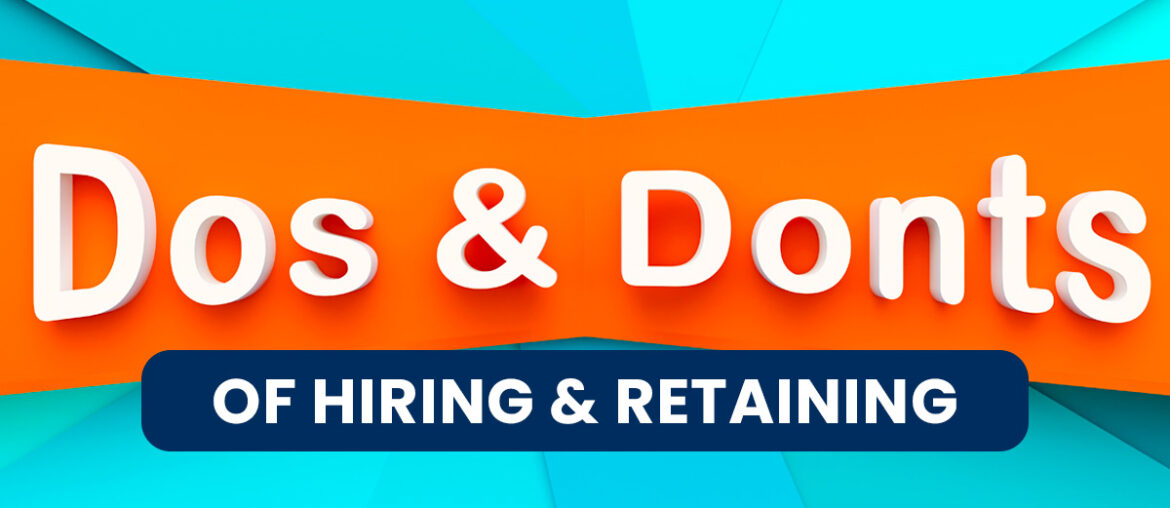Managing a distributed workforce in field service companies comes with unique challenges and opportunities. Effective hiring, retention and termination practices are crucial for ensuring that remote teams operate efficiently and deliver exceptional service. At a recent conference for software users, WorkWave partnered with Applause, a technology company with expertise in helping companies support and maximize employee engagement. Using their advice as a guide, field service companies can learn how to improve their hiring processes and set employees up for long-term success.
The Challenges of Managing a Remote Workforce
Though remote work is a work style that has gained in popularity since the pandemic, the reality is that field service companies have been managing distributed workforces for a long time. While many might think ‘remote’ refers to working from an employee’s home rather than an office, it can actually include all employees who do not work at a centralized office space to complete their work.
Field service companies — businesses operating in industries such as pest control, lawn care, HVAC, etc. — require a large portion of their workforce to be ‘distributed,’ servicing job sites remotely. This typically includes a single worker, or sometimes a small team or crew, with limited in-person interactions with the office.
Effective hiring practices are vital for field service companies to ensure they bring on board skilled and reliable employees who can work independently, excel at time management and perform quality services in a remote work environment. The right hires contribute to the overall success and reputation of the company.
The Dos of Hiring a Distributed Workforce
Field service industries often experience high rates of employee turnover. Because of constant churn, you have a crucial role to ensure your hiring practices are optimized to hire the best candidates (and reduce the odds of quick turnover down the road). Here are some tips we have for things you want to do in the hiring process.
Do: Leverage Employee Referrals for Quality Candidates
45% of employees obtained through employee referrals stay for more than four years. Knowing that employee churn is one of the leading challenges field service companies face, companies can reduce turnover by leaning into employee referrals as a primary hiring tactic.
This strategy involves encouraging current employees to recommend potential candidates from their professional and personal networks. Leveraging employee referrals during the recruiting process can lead to numerous benefits, but requires careful implementation to maximize its effectiveness. Take a look at the benefits and challenges below:
Benefits of Employee Referrals
- Higher quality hires: Employees are likely to refer individuals they know to be skilled and reliable.
- Cultural fit: Referred candidates often understand the company culture better through their connection with current employees.
- Reduced time and cost: Referrals can shorten the recruitment process and reduce advertising costs.
Challenges of Employee Referrals
- Bias and diversity: Relying too heavily on referrals can lead to a less diverse workforce, as employees may refer candidates too similar to themselves.
- Inconsistent quality: Not all employees have the same judgment or network quality, leading to varied referral success.
- Referral management: Tracking and managing referrals efficiently requires a structured process to ensure all candidates in the selection process are considered fairly.
Do: Create Role-Specific Scorecards for Objective Evaluation
Develop scorecards tailored to each role to objectively evaluate candidates’ qualifications and suitability for the position. Role-specific scorecards serve as a structured and objective method to evaluate candidates, ensuring that hiring decisions are consistent, fair and aligned with the specific requirements of each role. Here’s a deeper look into the importance and implementation of role-specific scorecards:
Objective evaluation: Scorecards provide a standardized framework for evaluating candidates. By focusing on predefined criteria, they minimize subjective biases and ensure that all candidates are assessed based on the same standards, including framing the same performance expectations for all.
Consistency across interviews: Using scorecards ensures that every interviewer evaluates candidates consistently. This is particularly important in a distributed workforce where multiple interviewers across different locations may be involved in the hiring process.
Alignment with job requirements: Scorecards help ensure that the evaluation criteria are directly aligned with the specific needs and responsibilities of the role. This alignment increases the likelihood of selecting candidates who are truly suited for the position and helps to avoid future performance issues.
Clear documentation: Scorecards create a documented trail of the evaluation process. This is useful for justifying hiring decisions, providing feedback to candidates and reviewing the effectiveness of the hiring process.
Enhanced communication channels: Scorecards facilitate effective communication among hiring team members. They provide a clear basis for discussion and comparison of candidates, making it easier to reach a consensus.
Do: Develop Standardized Interview Questions
Standardized interview questions help maintain consistency and fairness in the hiring process, ensuring that all candidates are assessed on the same criteria. They will help ensure a level playing field across all interviewees. It helps eliminate bias and allows for a fair comparison of all candidates based on their responses to identical questions. Standardized questions ensure that all critical aspects of the role are covered during the interview. This comprehensive approach helps identify the best candidates who meet the job requirements and fit the company culture.
Examples of Standardized Interview Questions for a Field Service Technician’s Interview Process
- Technical skills:
- “Describe your experience with troubleshooting and repairing electrical systems.”
- “What tools and software do you typically use for diagnostics and repairs?”
- Customer service skills:
- “Can you give an example of a time when you had to handle a difficult customer situation?”
- “How do you ensure customer satisfaction during service calls?”
- Problem-solving abilities:
- “Tell me about a challenging technical issue you solved recently. What was your approach?”
- “How do you prioritize tasks when you have multiple service calls in one day?”
- Adaptability and flexibility:
- “Describe a time when you had to adapt to a significant change in your work environment or procedures.”
- “How do you handle unexpected changes or emergencies during your workday?”
- Cultural fit:
- “What do you value most in a work environment?”
- “How do you stay motivated and productive when working independently?”
Do: Check References Thoroughly
Conduct comprehensive reference checks to verify candidates’ past performance and reliability, particularly in remote work settings. References can confirm the accuracy of the candidate’s resume and interview claims, revealing strengths and potential red flags that may not be evident during the interview.
This step helps employers make informed decisions, reducing the risk of hiring individuals who may not fit the company culture or meet job expectations. Reference checks can also highlight a candidate’s achievements, reliability and interpersonal skills, ensuring a more comprehensive evaluation and increasing the likelihood of a successful hire. At the very least, references can help indicate if a candidate has been a reliable team member in past work experiences.
Do: Utilize Digital Tools for Remote Hiring Processes
For many field industries, especially in areas of security or cleaning, one of the biggest challenges during the hiring process is actually getting employees to show up for interviews. Many potential employees may rely on public transportation or be traveling from far away to come to a centralized office for an interview, but are able to secure transportation to potential job sites that are closer to their residence more easily. So, it’s important for hiring managers to make the interviewing and hiring process as easy as possible for these employees.
Leverage technology, such as recruiting software, video conferencing, applicant tracking systems and digital assessment tools, to streamline the remote hiring process. Here’s how companies can make the most of available technologies in these critical areas:
Applicant Tracking Systems (ATS):
- Streamlining applications: An applicant tracking system can help manage large volumes of applications by automating the initial screening process, ensuring that only qualified candidates move forward.
- Centralized database: Maintain a centralized database of all applicants, making it easier to track their progress and communicate with them.
- Compliance: Migitage compliance risks and ensure compliance with legal and regulatory requirements by tracking all stages of the hiring process.
Video Interviewing Platforms:
- Remote interviews: Conduct video calls and interviews to accommodate remote candidates, reducing the need for travel and scheduling conflicts.
- Recorded interviews: Record interviews for later review and comparison, ensuring consistency and reducing bias.
- Automated scheduling: Use scheduling software to automate the interview scheduling process, improving efficiency and candidate experience.
The Don’ts of Hiring a Distributed Workforce
Since we’ve covered some advice on tactics recommended to help build an engaged workforce, it’s a good idea to cover some of the areas you don’t want as part of your hiring process.
Dont: Use Discriminatory Practices in Job Postings & Interviews
Ensure that job postings and interview questions are free from discriminatory language and bias. Use neutral language in job postings and descriptions to avoid implying a preference for a specific gender, age group or other protected characteristic. Phrases like “young and energetic” or “digital native” can inadvertently exclude older applicants. Implement standardized evaluation criteria to ensure that all candidates are assessed on the same basis, reducing the likelihood of biased decision-making.
Don’t: Make Unintended Promises During Interviews
Promises about job security, promotions or specific working conditions that cannot be guaranteed can create false hopes and lead to dissatisfaction or disputes if not fulfilled. Such assurances might be interpreted as binding commitments, potentially resulting in legal challenges if the promises are not kept. To maintain transparency and trust, interviewers should focus on the immediate responsibilities and opportunities within the role, clearly communicate company policies and avoid speculating on future possibilities that are not certain. This approach not only protects the organization from legal risks but also fosters a realistic and honest relationship with prospective employees, setting the stage for a positive work environment.
Don’t: Rush the Hiring Process
It’s important not to rush the hiring process, because thorough evaluations are crucial for making informed decisions that benefit both the company and the candidate. This can be hard, especially if your business is experiencing gaps in your current contracts and you need people on the job, fast. Still, rushing the hiring process can lead to overlooking essential qualifications, cultural fit and potential red flags, resulting in poor hiring choices that negatively impact team dynamics, productivity and overall business success. Taking the time to carefully assess candidates through multiple stages, including screenings, interviews and reference checks, ensures a better fit for the role, reduces turnover and enhances long-term team performance and morale. A deliberate hiring process also reflects well on the company’s reputation, providing a positive experience that attracts top talent.
Best Practices for Interviewing Remote Candidates
- Structure virtual interviews effectively: Plan and structure virtual interviews to cover all necessary topics and ensure a smooth process.
- Assess remote work skills and self-motivation: Evaluate candidates’ abilities to work independently, manage their time effectively and stay motivated in a remote environment.
- Ensure cultural fit in a distributed environment: Assess whether candidates align with the company’s values and culture, which is crucial for maintaining a cohesive remote team.
Onboarding & Training Distributed Teams
- Create clear paths to success for remote employees: Develop clear onboarding processes that outline expectations, resources and support for new remote employees.
- Implement effective virtual training programs: Use virtual training programs to equip remote employees with the necessary technical and communication skills and knowledge for their roles.
- Set clear expectations and performance metrics: Establish clear expectations, performance reviews and performance metrics to guide remote employees and measure their success.
Conclusion
Effective management of a distributed workforce requires careful attention to hiring, retention and termination practices. And remember: don’t let your people go to a dark place. 66% of employees say they leave due to lack of appreciation. By following the outlined dos and don’ts, field service companies can build and maintain a productive, engaged and compliant remote team. Adapting to the unique challenges of managing a distributed workforce is essential for achieving long-term success in today’s dynamic work environment.




